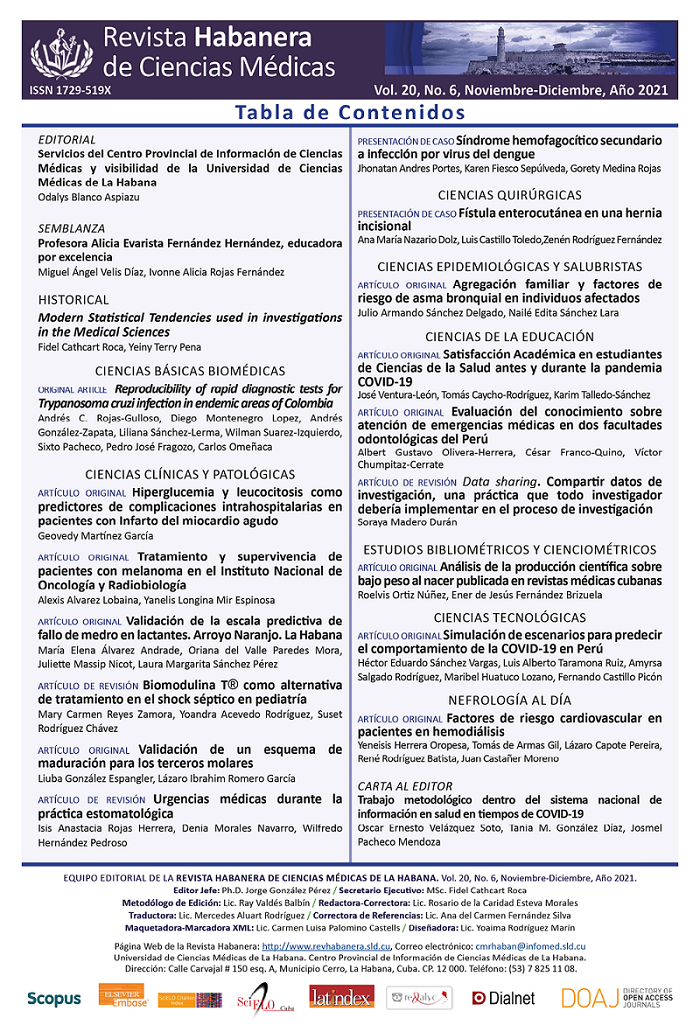Treatment and survival of patients with melanoma at the National Institute of Oncology and Radiobiology
Keywords:
Skin cancer, melanoma, locally advanced melanoma, immunotherapy.Abstract
Introduction: Melanoma is a potentially lethal disease that is associated with a high morbidity and mortality rates due to the high risk of regional or distant nodal metastasis.
Objective: To describe the demographic and clinical-pathological characteristics and the therapeutic procedure, as well as to determine the survival in the patients evaluated in the study.
Material and Methods: A descriptive and retrospective study was carried out in a group of seventy-nine patients suffering from locally advanced stage III melanoma during 2003-2018 period. Data were taken from the documentary review of clinical histories and the records of the Department of Pathological Anatomy.
Results: Regarding the clinical-pathological variables, men comprised 51,9 % of the sample, and the superficial extension in the histological subtype represented 44,1 % of the sample. About 64,6 % and 35,4 % of patients were diagnosed in stage IIIB and stage IIIC, respectively. The removal of the primary lesion was performed as the only treatment option in 35,1 % of the patients, and Interferon Alfa was used in 80 % of those who received immunotherapy. Up until the analysis of 67 patients, it was demonstrated that 84,8 % of them had improved while 83,5 % had died. The median progression-free survival was 1,0 years and the global survival was 1,10 years.
Conclusions: The superficial subtype predominated in the group of patients studied. There was a discrete prevalence of males and stage IIIB. The most commonly indicated therapeutic procedure was the removal of the primary lesion. Both the median progression-free survival and the global one were low.Downloads
References
1. Infante Carbonell MC, González Calzadilla ME, Jaén Infante L. Valle Piñera S. Melanoma cutáneo: algunas consideraciones actuales. MEDISAN. 2019;23(1):146-64.
2. Garbe C, Peris K, Hauschild A, Saiag P, Middleton M, Bastholt L, et al. Diagnosis and treatment of melanoma. European consensus-based interdisciplinary guideline e Update 2016. Euro J Cancer. 2016; 63:201-17.
3. Schadendorf D, Van Akkooi AC. Melanoma: diagnóstico y tratamiento. Lancet. 2018;392:971-84.
4. Álvarez Lobaina A. Caracterización de pacientes con melanoma localmente avanzado en el Instituto Nacional de Oncología y Radiobiología. Folia Dermatológica Cubana. 2020;14(2):e137.
5. Michielin O, Hoeller C. Gaining momentum: New options and opportunities for the treatment of advanced melanoma. Cancer Treat Rev. 2015;41(8):660-70.
6. Gimotty PA, Elder DE, Fraker DL. Identification of high-risk patients among those diagnosed with thin cutaneous melanomas. J Clin Oncol. 2017;25(9):1129-34.
7. Nieweg OE, Gallegos Hernández JF. La cirugía en melanoma cutáneo maligno y las nuevas drogas. Academia Mexicana de Cirugía. 2015; 83(2):175-80.
8. Mahul BA. AJCC Cancer Staging Manual. 4 ed. New York: Springer Science an Business Media; 2002.
9. Camacho Limas CP, Gerson Cwilich R, Góngora Jurado MA, Villalobos Prieto A, Blanco Vázquez YC, López Riverol O. Actualidades para el tratamiento del melanoma metastásico, estado del arte. An Med (Mex). 2017;62(3):196-207.
10. Mulliken J, Russak J, Rigel D. The Effect of Sunscreen in Melanoma risk. Dermatol Clin.2014;30:369-76.
11. Dirección de Registros Médicos y Estadísticas de Salud. Anuario Estadístico de Salud 2019 [Internet]. La Habana: MINSAP; 2020 [Citado 11/06/ 2020]. Disponible en: https://temas.sld.cu/estadisticassalud/2021/08/11/anuario-estadistico-de-salud-2020/
12. Berwick M, Erdei E, Hay J. Melanoma Epidemiology and Public Health. Dermatol Clin. 2015; 27(2): 205-14.
13. Martínez Said H, Cuéllar Hubbe M, Barrón Velázquez E, Padilla RA, Herrera Gómez A, López Graniel CM. Epidemiology of cutaneous melanoma in Mexico (1982-2002). Eur J Surg Oncol. 2014;30:163.
14. Martínez SH. El primer Consenso Nacional de Expertos en Melanoma. Gac Mex Oncol. 2015;4(2):11-3.
15. Oficina Nacional de Estadística e Información. El Color de la Piel según el Censo de Población y Viviendas de 2012. La Habana: Centro de Estudios de Población y Desarrollo; 2016.
16. Arora A, Attwood J. Common Skin Cancers and Their Precursors. Surg Clin N Am. 2014;82:703-12.
17. Curin JA, Fridlyand J, Kageshita T, Patel HN, Busam KJ, Kutzner H, et al. Distinct sets of genetic alterations in melanoma. N Engl J Med. 2015;353(20):2135-47.
18. Quiroga Mendieta L, Mendoza López JN, Ramos Loza CM. Melanoma maligno metatastásico: reporte de caso. Rev Med La Paz. 2017;23(2):40-4.
19. Ramos Álvarez M, Ruiz Leal A, Sánchez Dueñas L, Crocker Sandoval A, Sánchez Tenorio T, Orendain Koch N, et al. Melanoma en la práctica privada en México: un diagnóstico oportuno. Dermatología Revista Mexicana. 2015;59(2):89-97.
20. Yabor Palomo AM, Díaz Pérez M, Peña Pérez OR, Álvarez Yabor V, Morales Fontaine A. Melanoma maligno cutáneo en pacientes de la provincia de Las Tunas. Revista Electrónica Dr. Zoilo E. Marinello Vidaurreta [nternet]. 2015 [Citado 11/06/2020];40(12):[Aprox. 8p]. Disponible en: http://revzoilomarinello.sld.cu/index.php/zmv/article/view/483
21. Tuong W, Cheng L, Armstrong A. Melanoma: Epidemiology, Diagnosis, Treatment, and Outcomes. Dermatol Clin. 2012;30(1):113-24.
22. Herrera NE, Aco AY. Melanoma en México: artículo de revisión. Revista de Especialidades Médico-Quirúrgicas. 2014;15(3):161-4.
23. García M, Díaz S, Gutiérrez A, Sánchez J, Sánchez R. Experiencia Clínica en el tratamiento adyuvante de los pacientes con melanoma de tronco y extremidades estado III en un hospital del tercer mundo. Revista Colombiana de Cancerología. 2015;19(1):125-32.
24. NIH. Melanoma: Tratamiento–para profesionales de salud. [Internet].USA: Instituto Nacional del Cáncer de los Institutos Nacionales de la Salud de EE.UU; 2015 [Citado 11/062020]. Disponible en: http://www.cancer.gov/espanol/tipos/piel/pro/tratamiento-melanoma-pdq
25. Phan A, Touzets SB, Thomas BL. Acral Lentiginous Melanoma Histopathological Prognotic Features of 121 cases. BR J Clinic Dermatol. 2007;157(2):311-8.
26. Marchese ML, Stringa M, Valdés R. Factores pronósticos en el melanoma. Dermatol. 2017;23(1):3-12.



